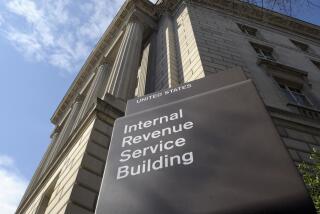IRS Offers Help if You Can Get Past Screening
- Share via
Very, very quietly, on page 19 of its main taxpayer instruction booklet, the Internal Revenue Service announces a gift from the gods--”a Problem Resolution Program” to help with problems that taxpayers “have been unable to resolve through the normal channels.” Need someone to “take responsibility for your problem and ensure that it receives proper attention?” Just call “and ask for Problem Resolution assistance.”
Many taxpayers are ignorant of its availability. “What is it? Something like a help line?” asks one taxpayer. Another lost his initial interest on hearing that he must start with the local IRS information line: “I’ve never been successful getting them on the phone,” he sighed.
Odd, when the program has been around since 1977. Taxpayer service--itself supposed to handle taxpayer inquiries and problems--was then six years old, but “it was evident that some things were not being taken care of,” says Jack Petrie, the national ombudsman for the IRS. Indeed, he says, a half-dozen congressional bills threatened intervention into IRS treatment of taxpayers, and “we thought we would jump the gun and do it ourselves.”
Limited Public Contact
To provide “advocacy” for the taxpayer, the Problem Resolution Program, or PRP, was created, threaded through the IRS’ divisions. There are supervising Problem Resolution Officers in each of the IRS’ seven regions, 64 districts and 10 service centers. But these have limited public contact, being also responsible for reviewing all procedures and materials going out to taxpayers and for analyzing taxpayer problems in an effort to identify those that are “systemic,” or recurrent system-wide.
The taxpayer’s greater interest is probably the PRP’s handling of individual problems-- 548,000 this past fiscal year, most commonly involving second and third notices demanding payments already made, questions about employer federal tax deposits, “entity problems” (incorrect Social Security numbers or unknown names) or refunds not received on time. This work is done by PRP “caseworkers” in each IRS division--collection, examination, taxpayer service, appeals, etc.
Taxpayers wanting this special help must still call the same old toll-free number offered for any and all “taxpayer assistance.” Those “first-line assistors,” says Cheryl Palmer, Los Angeles district Problem Resolution Officer, “are trained to probe the inquiry, trying to find out if they qualify for Problem Resolution.” If they do, the inquiry is written up and passed on to a PRP caseworker in the appropriate area and division, who should contact the taxpayer within 10 days.
Rules to Qualify
The rules for qualification seem very specific, if incomprehensible: e.g.,”REFUNDS--A second or subsequent refund inquiry received 90 days after the first filing of an original or amended return or a claim. NOTE: An inquiry received prior to the 90 days should not be counted in applying the criteria.” This somehow means that a refund problem qualifies for PRP attention if the taxpayer has filed his return, heard nothing for 90 days, made an inquiry and still heard nothing after 45 days.
The taxpayer also qualifies if he has called or written (on something other than refunds) and received no response to his inquiry within 45 days, or if he has received a third demand for payment on something about which he made an inquiry and never received attention or appropriate action. But there are several exclusions, including one disqualifying the taxpayer if “an appropriate response has previously been provided,” whatever that may be.
Once reached, PRP caseworkers have some clout within the IRS, because “problem resolution is a top priority program,” says Petrie. They have on-line computer access to taxpayer records, so they can check whether payments have been received or refunds sent, and can call whoever has been or should be involved in the case. They may, of course, request more copies of canceled checks, audit adjustments or other documents but they “strive to have the matter resolved within 30 days,” says Palmer.
Their authority, however, has limits. “We intercede to make sure someone pays attention,” says Palmer, “but we don’t override the decisions of the division involved. We can’t be a second line of appeal.” At the same time, says Petrie, the PRP as taxpayer advocate does “have an appeals function. If we disagree with a proposed deficiency, or if a penalty is too harsh, the Problem Resolution Officers may speak out for the taxpayer, even if they don’t have final authority.”
If a PRP caseworker seems unhelpful, the taxpayer, says Palmer, “should talk to that caseworker’s manager,” and subsequently go beyond the manager to the Problem Resolution Officer in the district, region, or service center. She points out, however, that “the calls I get are usually from people who just refuse to believe something.”
Some taxpayers say it isn’t easy to leap over the first lines and get help from the top. Indeed, the IRS, like many businesses, gives volume customers preferential treatment: Professional tax preparers are given the Problem Resolution Officers’ direct phone numbers for use in special cases. Tax preparers, explains Petrie, are considered a resource: dealing as they do “with tax problems on a more mass basis, they’re better able to recognize the (Problem Resolution) criteria and to identify systemic problems.”
Typical systemic problems include last year’s “input problem,” when a computer didn’t input any cents and gave people $5.00 instead of $500, or the recurring problem of Social Security numbers that don’t fit names because women have married and changed their names or the rejection of some federal tax deposit coupons by IRS scanners. PRP solutions: a computer program correction, a campaign urging women to notify Social Security if they change their names, new instructions requiring that taxpayers use ink or No. 2 pencils on federal tax deposit coupons.
Petrie thinks the Problem Resolution Program is as important in encouraging what the IRS calls the taxpayer’s “voluntary compliance” as the audit program, which he likens to the presence of state police on a highway: “They make you look at your speedometer. The audit program has impact on one side; on the other side, we can provide a service to help. We can’t show voluntary compliance gains in dollars and cents, but if we don’t do it, it’s probable that people won’t comply voluntarily.”
More to Read
Inside the business of entertainment
The Wide Shot brings you news, analysis and insights on everything from streaming wars to production — and what it all means for the future.
You may occasionally receive promotional content from the Los Angeles Times.










